Thanksgiving in January: a Pilgrim Sandwich
Thanksgiving in the US is a holiday that nominally is about showing gratitude, celebrating a cuddly myth we have about 17th Century buckle-fetishizing colonists and the friendly natives who’d helped them survive their first year on these shores sharing a harvest festival together (though the descendants of those natives view it somewhat differently). Traditionally, it is a harvest feast like those held by many cultures, a pause between the work of the late summer / early autumn and prepping for the winter. Officially, it was pronounced a National Holiday in 1863 by President Abraham Lincoln, who declared it “a day of Thanksgiving and Praise to our beneficent Father who dwelleth in the Heavens.”
Culturally, it is a celebration of conspicuous consumption, much like the many other observances in our society that have been coopted by capitalism. There is the commercial leadup to Thanksgiving, the changing of the store decorations, the seasonal products on offer, the way the ads lean more maudlin the closer it gets to Thanksgiving and Christmas, the massive yet seemingly unconnected corporate entities moving in as tight as unison as the murmuration of a flock of birds; the lavish feast of course, the turkeys and cranberries and pumpkin pies and sweet potatoes and the rest, many of the ingredients for which are far less available the rest of the year, an act of consumption in its most literal sense; and the post-Thanksgiving “Black Friday,” the busiest shopping day of the year even before our corporate overlords caught on and instituted the current frenzy of early-morning store openings and special limited “while supplies last” sales that cause riots year after year. Televised parades celebrate corporations; op-eds tout the first Thanksgiving as the triumph of capitalism over socialism
There’s much not to like about Thanksgiving. But for me, and for many others, the holiday is about 2 things: family and food, mostly in that order. Mostly. Our Family Thanksgiving, like that of many people, may have a slightly rotating cast of characters–Mom and Ronnie are a given–it’s their house–but on any given year I may be there with Mindy and our three sons; my sister Ali can reliably be expected to come as she lives nearby, but sometimes her work can interfere; my brother Eric who lives in North Carolina is often there, and his wife Michelle when she can make it; my sister Bridget usually makes the drive up from Nashville, and her boyfriend Brian has joined us the past few years; and any number of friends who’ve called Mom’s house home over the years (and often called her Mom the same as us). It’s a mix of the family we were born with and the family we have chosen, and there are none of the Thanksgiving tensions I’ve read about in other people’s accounts because we all just like each other. (Though I will admit, if my brother and sisters had kids, I’d probably be the loud, annoying uncle.)
It does though consist of certain fixed points: the turkey, Mom’s stuffing (it is technically a dressing, and for the past 10 years or so I’ve been the one making it, but it is and will always be Mom’s stuffing), mashed potatoes and gravy, cranberry sauce (both the homemade kind and the gelatinous red cylinder that comes in a can), dinner rolls. We always have a relish tray for holiday feasts consisting of pickles, olives, and stuffed celery; someone will usually make green bean casserole (my kryptonite) and baked yams; Mindy’s Waldorf salad has become a favorite since she first introduced it a couple decades ago. Nothing terribly surprising there–traditional foods and a traditional dinner (dinner in the Midwestern sense, eaten at around 1pm); Mom asks everyone around the table what they’re thankful for, and we all try to answer without cracking too many jokes; Ronnie says grace; we eat ourselves into a food coma, some folks watch football or play board games or take naps or just sit around and catch up. Most of us forgo the bombardment of enticements to partake in the following day’s tsunami of spending and instead concentrate on the third most-important part of Thanksgiving: the creative use of leftovers.
Hence comes this entry’s sandwich, the ubiquitous yet ever-changing sandwich made from Thanksgiving’s leftovers. Sometimes called the Pilgrim sandwich (or even, according to Wikipedia, the Puritan), the “Moistmaker” a la TV’s Friends, or just the Thanksgiving leftovers sandwich, it is among the more popular uses of these leftovers, piling turkey, gravy, cranberry sauce, stuffing, and any number of other ingredients into a torpedo roll, a Kaiser, or just one of the leftover dinner rolls; perhaps between two slices of bread, wheat bread or sourdough, toasted or un. Some people add cheese, whether Cheddar or Muenster or American or Swiss (or any of the endless other types that would suit). There are no rules nor set list of ingredients, it’s just a sandwich using Thanksgiving leftovers.
I have a secret. I don’t really ever make these. Oh, I might put a piece of turkey in a dinner roll with some butter or cheese and pickles, and I certainly have plenty of different tasty (to me) ways that I do my part to use up all that leftover turkey and stuffing and gravy. But I’ve never been a fan of the Pilgrim sandwich as conceived by many Americans. My friend Jonathan, who started the website Bounded by Buns last year, is a fan of them, and wrote a very good article about them a few months ago, and I would not be offended at all if you clicked over there and skipped reading mine entirely.
But I’ll give it a shot anyway.
Turkey
I have mentioned here before that I love turkey, and I usually roast several of them throughout the holidays. This is in part because I make really terrific turkey roasts. There are 2 techniques that are key to my success–no recipes, not really, just techniques.
First is dry-brining. Several days before the dinner, I make a dry-rub using various poultry herbs (sage, thyme, rosemary, etc), white pepper, kosher salt, and whatever else strikes my fancy at the time–garlic and/or onion powder, paprika, dried orange peel, ginger powder, etc. I remove the neck and giblets from the cavities of the turkey, pat it as dry as I can, and rub the spice all over the turkey skin, getting as much of it to adhere to the surface as I can. Then I wrap the turkey up in a plastic bag just as tightly as I can, usually double- or triple-bagging it, and refrigerate it until the morning of the dinner.
Traditional brining does the same thing, but with the salt and seasonings dissolved in quite a bit of water. The concept behind dry-brining is that brining is not only using osmosis from the salt to put flavor into the turkey, but it is also drawing flavor out of the turkey at the same time–instead, dry-brining uses the turkey’s own moisture to create a more concentrated turkey-flavored brine that also carries the flavors of the dry rub. Less water = more flavor.
Second is spatchcocking. Go ahead and laugh–spatchcock is funny to my inner 12-year-old as well. Spatchcocking refers to the practice of removing the spine from the bird and flattening it out before roasting. Some people don’t like this because the turkey doesn’t hit the table in that traditional breast-up presentation, or because there’s no real ability to stuff the bird in a spatchcocked roast. I generally carve the bird before it hits the table regardless, and Mom’s “stuffing” is technically dressing as I’ve mentioned, cooked in a separate pan, so neither of these are dealbreakers for me.
What spatchcocking the bird does well is put the meat that needs to cook longer and to a higher temperature (dark meat) out on the edges of the roast where it will do so, and the meat that needs to be protected from overcooking (white meat) in the center where it doesn’t cook as quickly. The bird browns more evenly, and the spine can be used along with the neck and giblets to enhance the stock for gravy or stuffing.
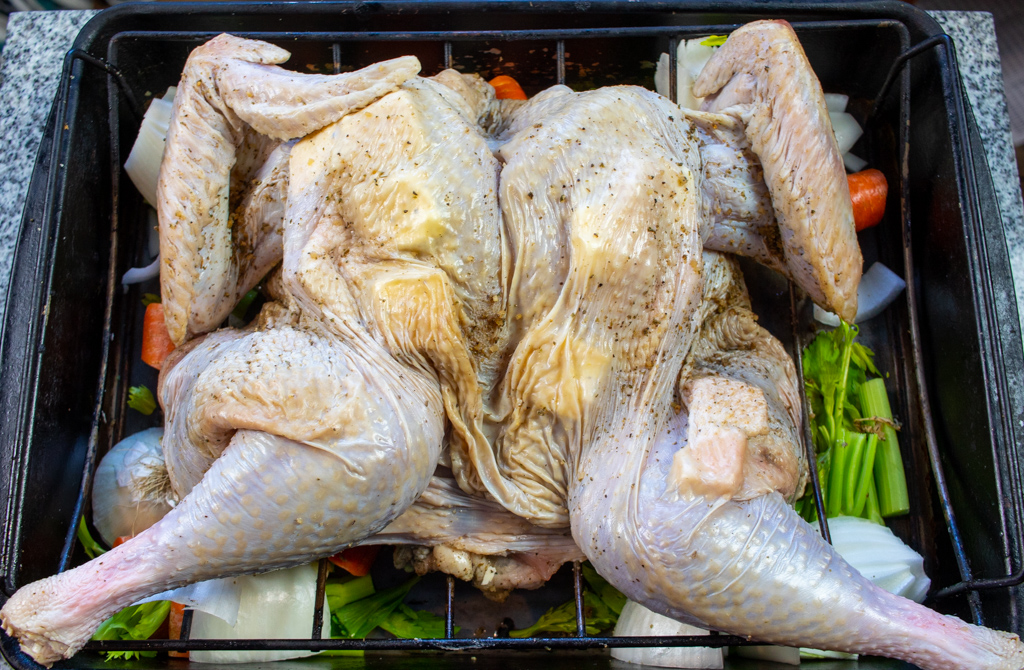
I reach underneath the skin and separate it from the meat as much as I can, dividing a stick of butter into 12 or 16 tabs that I distribute over the top of the roast, under the skin, to help keep the meat moist and the skin crisp. I put stock and vegetables into the roasting pan, the stock to help keep the drippings from scorching, and the vegetables to help flavor them–they’ll be used for gravy later. Since the roast is flatter and a more even thickness throughout, it can be roasted at a higher temperature for a shorter time, 80 or 90 minutes instead of the hours that a turkey might normally take to come up to temperature. The resulting roast looks like this:
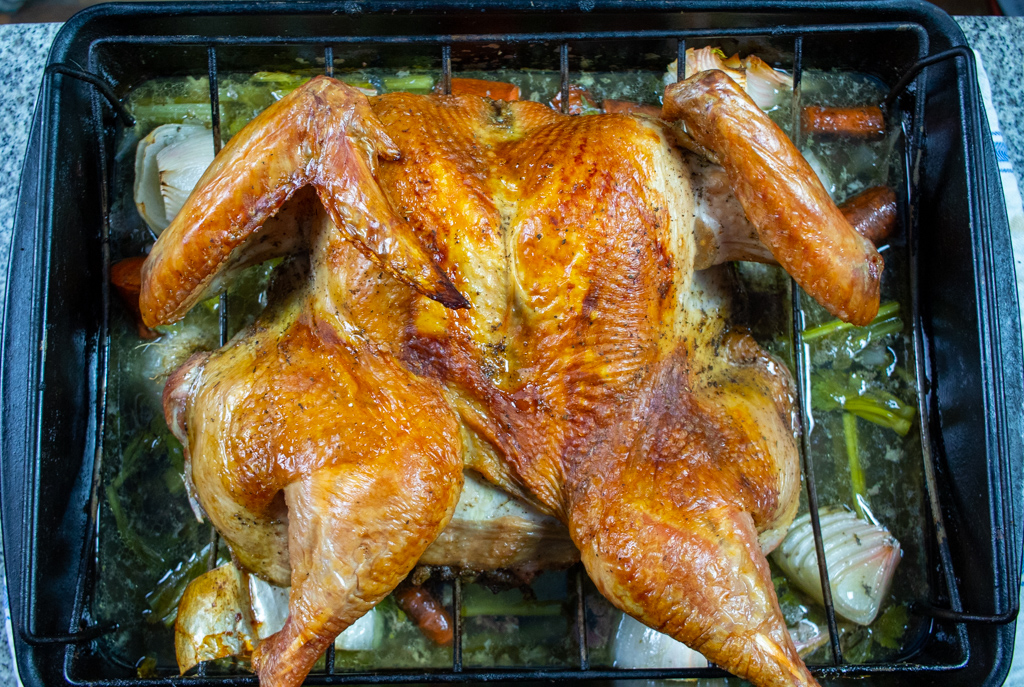
Mom’s Stuffing
Mom’s stuffing is special. It is among my favorite things to eat, and so much butter goes into making it that I can only be relieved that there are limited opportunities for it in the year. On the other hand–it is stuffing, it is not fancy, there are no sausages or oysters, dried fruits or nuts, cornbread or White Castle sliders or secret ingredients of any kind. It is the most basic of basic stuffings: stale white bread, onions and celery, sage and black pepper, turkey stock and eggs. It is an extremely simple savory bread pudding and you probably won’t like it at all. So why do we love it so much? There are, I believe, 2 reasons. 1) an absolutely obscene amount of butter; and 2) the crunchies.
What are the crunchies? Well, this stuffing gets roasted hard. The pan gets buttered to keep it from sticking, and the top gets some more butter just because, and then the stuffing gets put into the oven around the same time as the turkey and stays in there the whole time the turkey is roasting. When Ronnie is making the more traditional, non-spatchcocked version of turkey (which he does extremely well), that is a very long time indeed. When I am the one making the turkey, I have to put the stuffing in first and leave it in there while resting the bird for the same effect. The perfect serving of stuffing has some of the softer inner bread pudding along with plenty of the crisp, brown outer shell.
Again, stuffing is not so much a recipe as a process. A state of mind, even. Melt a stick of butter and sautee some finely-diced onion and celery–how much? Take a look at how much stale bread you have and guesstimate. When the onions and celery have started wilting and going translucent, add some sage and black pepper and salt–plenty of the first two, not too much of the latter. Meanwhile, break up the stale bread into bite-sized pieces in the biggest pan you have (’cause stale bread is bulky) and then pour some turkey stock over it, enough to wet and soften all the bread without turning it to complete mush. Then mix together the softened stale bread, the onion/celery/sage mixture, and about a half-dozen eggs (or less, or more, depending on how much stuffing you’re making). Put it into a buttered 9×13 pan and cut up another stick of butter to dot the top.
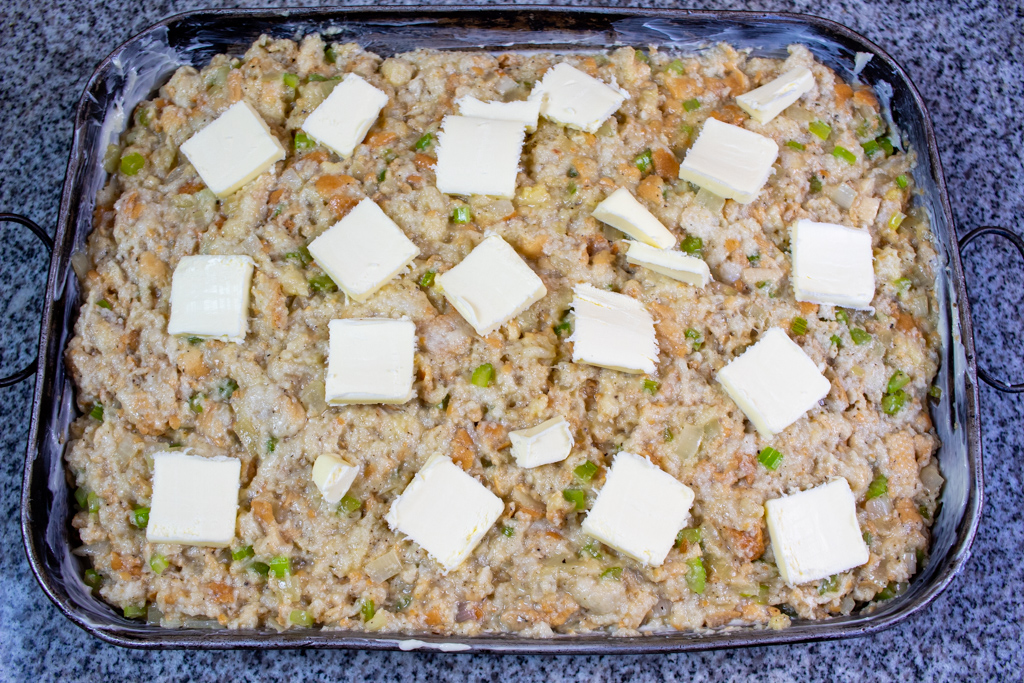
Make sure to put it on top of a cookie sheet while roasting it because the stuffing will swell up and some of that butter will go over the sides and that makes for a smoky Thanksgiving morning. You’re going to be roasting this for a while. This version was sufficiently crisp but could have stood to get quite a bit browner on top.
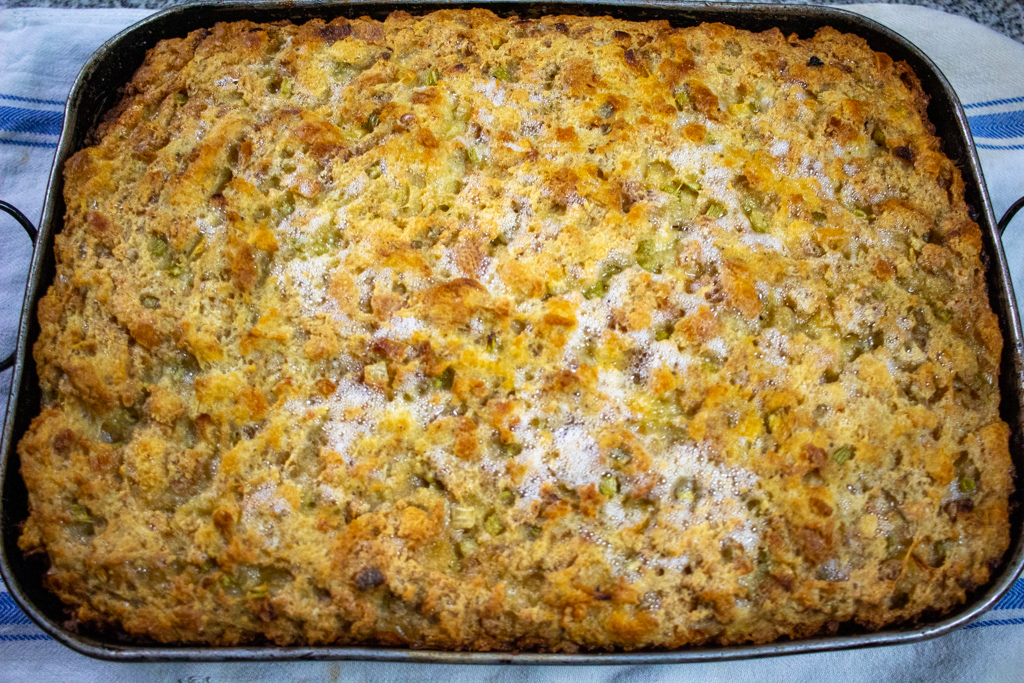
The Dinner
A friend of mine laughed when I said I’d be making this sandwich this month. “I assume you simply plan ahead,” he said, “but I think it’s funnier if you’re doing a whole second Thanksgiving dinner in January just to have the leftovers.”
Of course I planned ahead. I stuck a turkey in the freezer, knowing they’d be harder to find after the holidays were over. I did not, however, think to stash some homemade turkey stock for the stuffing and gravy, or to stash some fresh cranberries to make the sauce I prefer. Of course there are workarounds
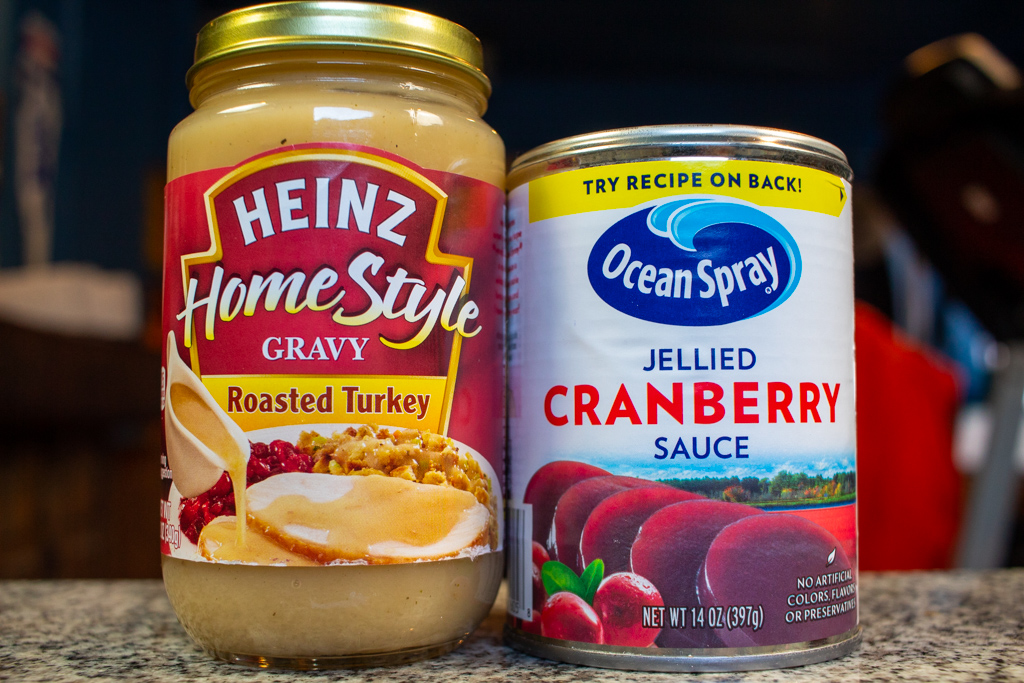
But let’s see how far I can get without them. First up, mashed potatoes, just some simple boiled russets, mashed then mixed with butter and heavy cream.
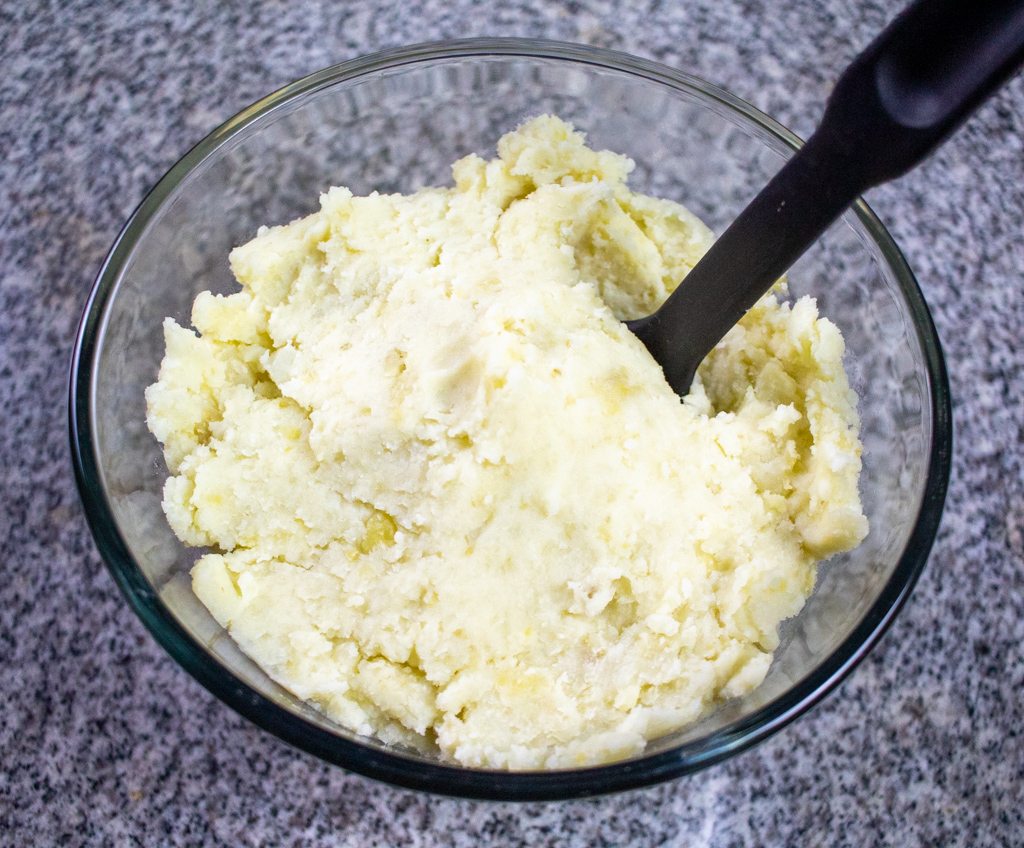
I used a stock I made from the giblets, spine, and neck to make the stuffing. Then I used the drippings from under the roast for the gravy. The liquid in the pan was half-water, half-chicken broth, but by the time the turkey had finished roasting it did not taste like chicken anymore. How to make it? Skim the fat, mix it in a pan with a little butter and flour to make a roux, cook the roux just a bit, then mix the rest of the stock in little by little until you have gravy. Pretty? No. But tasty.
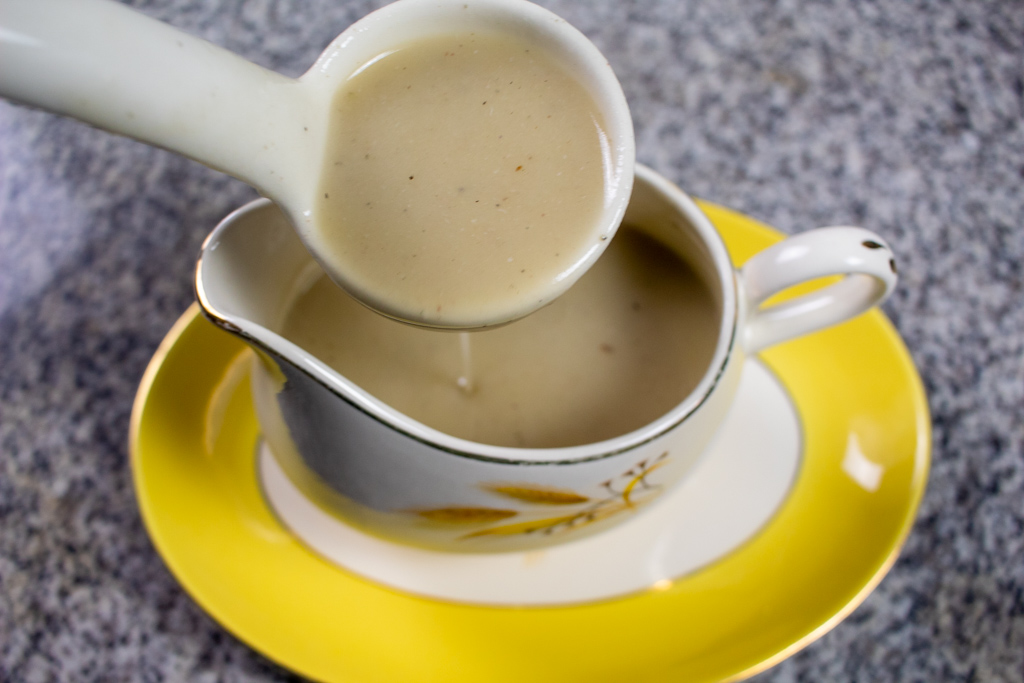
Homemade turkey gravy
I managed to make a cranberry sauce from dried cranberries using this recipe. It’s thickened with cornstarch rather than the natural pectin in the berries and the texture suffers a bit as a result. It’s head and shoulders above the stuff in a can though.
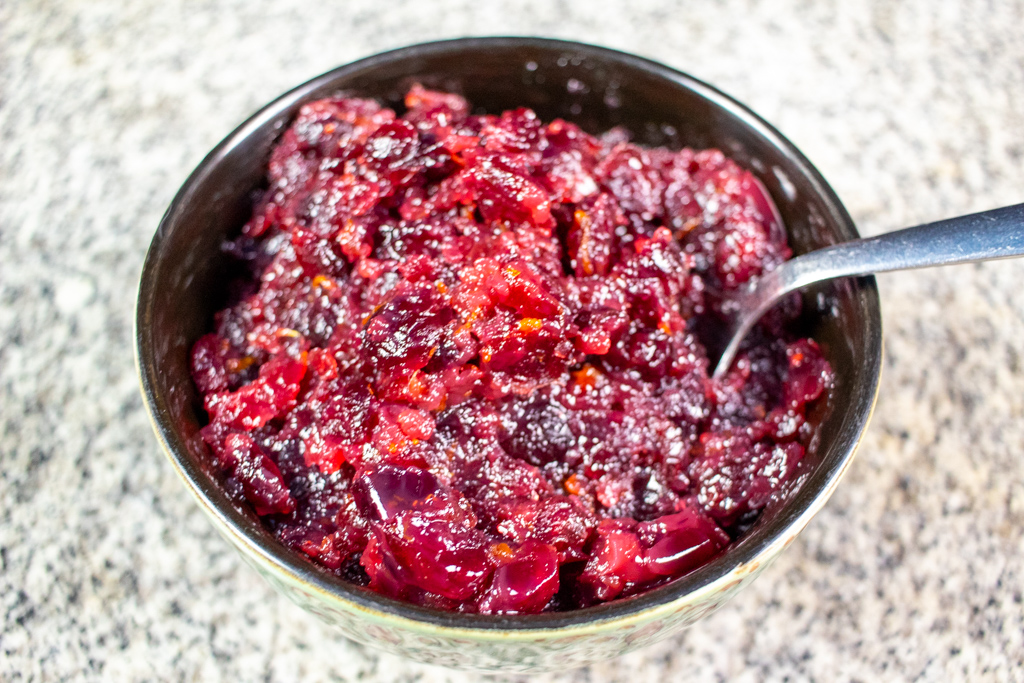
Mindy contributed her Waldorf salad, a perennial favorite of the whole family, made with Braeburn apples, grated carrots, diced celery, raisins, walnuts, and mayonnaise. We eat this at Thanksgiving, at Christmas, at barbecues and cookouts and basically whenever we have the opportunity. It’s great.

These are the dinner rolls I made to use as slider buns for my recent post on pig ear sandwiches. I froze them for a few days then thawed and reheated them the day of our Thanksgiving in January. They were as good as they had been fresh.
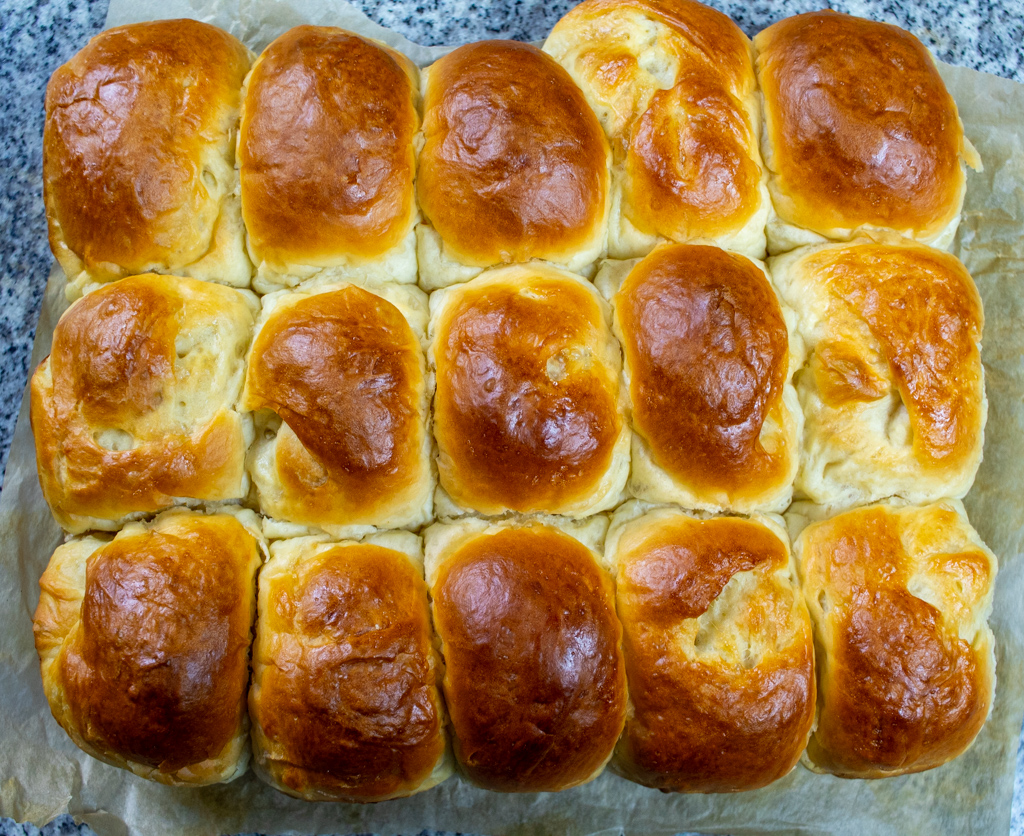
When I carve the turkey, I present it on two separate platters. One contains only the two breasts, sliced.

The other has the legs, the wings (which nobody ever eats–more for the stockpot later!) and the thighs, carved as neatly as I can manage (which isn’t very neat).
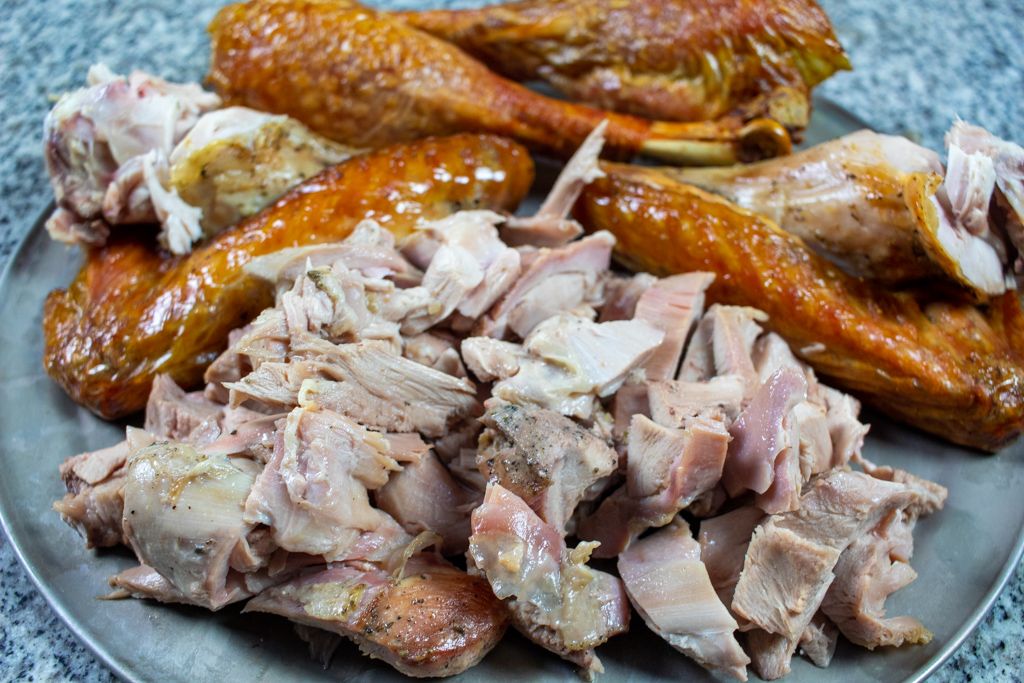
We have a small kitchen, and a small dinner table located within said small kitchen, and this amount of food leaves little space for plates.
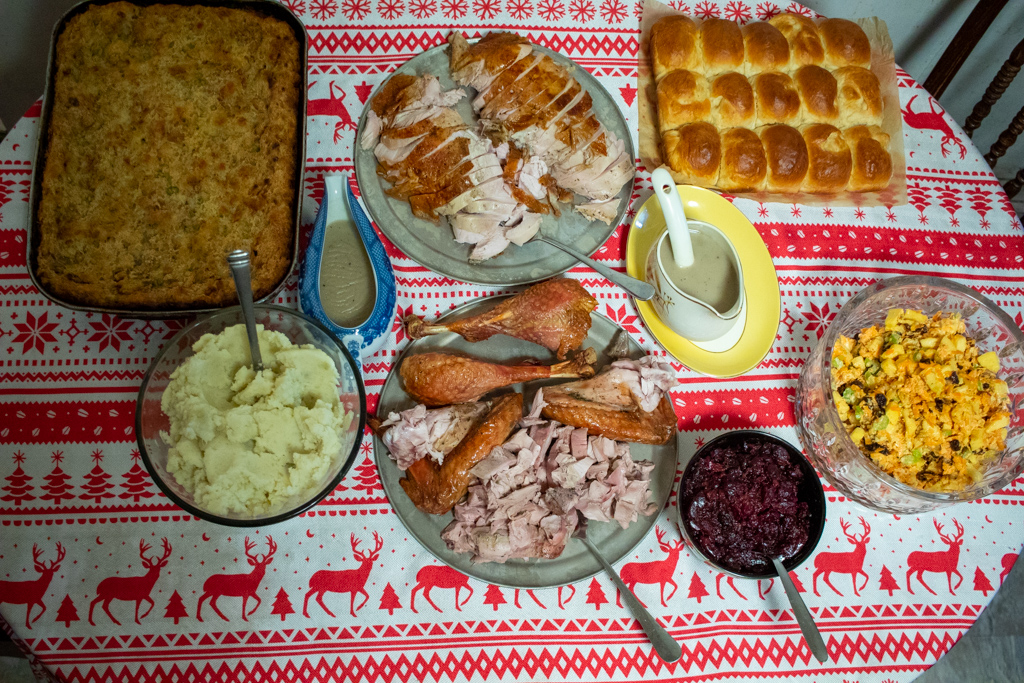
We manage, though. There are 3 of us at home now, and we sit, and we pass the dishes, and there is a little conversation but mostly a lot of chewing. I of course load up my plate with a little of everything.
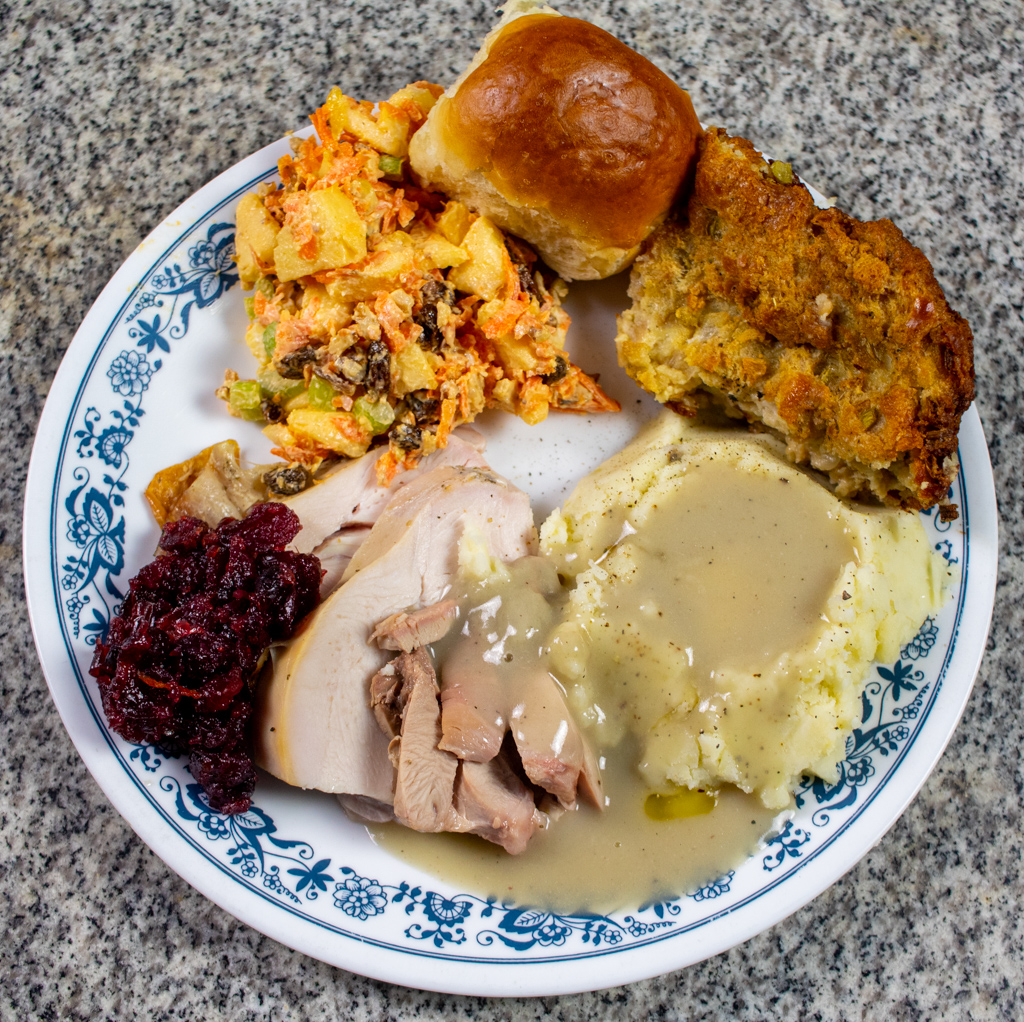
This time around, I even made an attempt at putting together a Pilgrim sandwich mid-meal, with a dinner roll, mashed potatoes and gravy, stuffing, turkey, and cranberry sauce.
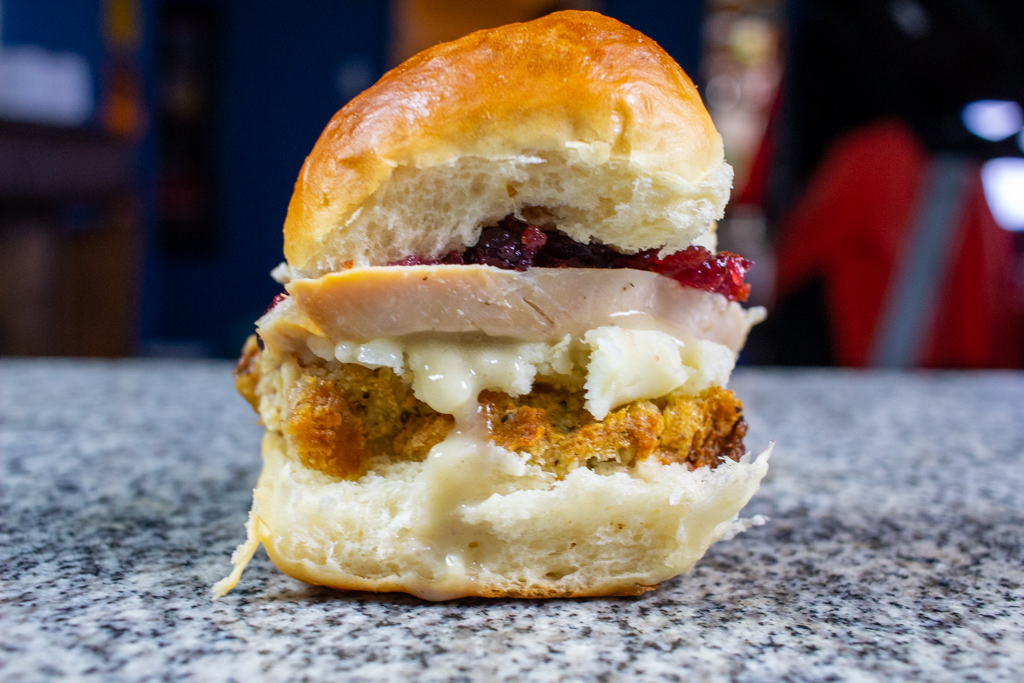
There was too much on my plate already though, and I couldn’t manage another bite. Besides, it only counts when you make this sandwich with…
The Leftovers
As I mentioned, I have not usually been one to make elaborate sandwiches based on Thanksgiving leftovers. I’m far more likely to make something simple like this: a buttered, griddled dinner roll, slice of turkey, some garlicky kosher dill pickle slices, and Merkt’s cheddar (in lieu of my favorite Kraft Old English cheese spread, which I’m stockpiling currently due to our difficulties in finding it last Christmas. When the end times come, you’ll find me in the back room of my house, holding court while sitting on a throne made of Old English Cheese jars.)



My most elaborate (and favorite) creation is this Eggs Benedict variant (Eggs Turkeydict? I don’t know I am not good at naming things) using crisp pan-fried stuffing in place of the English muffins, turkey instead of Canadian bacon, and gravy to stand in for the Hollandaise sauce. As for the poached eggs, I suppose you could say I poached these sunnyside-up beauties in butter.





The gravy lacks the lemony and buttery richness of the Hollandaise but blends just as well with egg yolk, and Mom’s stuffing is an improvement over an English muffin, as much as I like those. Also there is a sort of thematic unity to the turkey stuffing, turkey meat, and turkey gravy, though I suppose to take that to the next level I’d have to track down some turkey eggs.
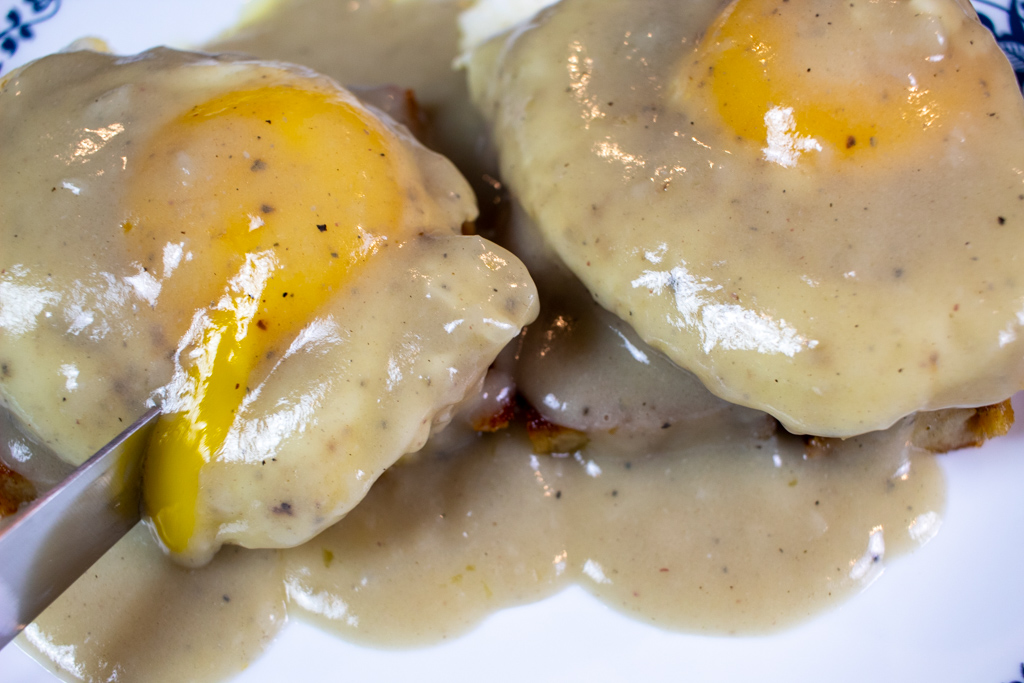
My initial attempt at the sandwich was completist, but not well-constructed I’m afraid. I started with a sub roll, added a thin layer of hot mashed potatoes and some gravy, then some pan-fried slices of stuffing, thick turkey slices fried in the same pan, cranberry sauce to dress the turkey, and some of the Waldorf salad as a kind of condiment on the top of the bun.







It was too much though–too tall, too much soft stuff at the bottom with too much stacked on top of it. It held together for a bite or two, then I found myself picking pieces of stuffing and turkey out of the pile of variegated mush it became.
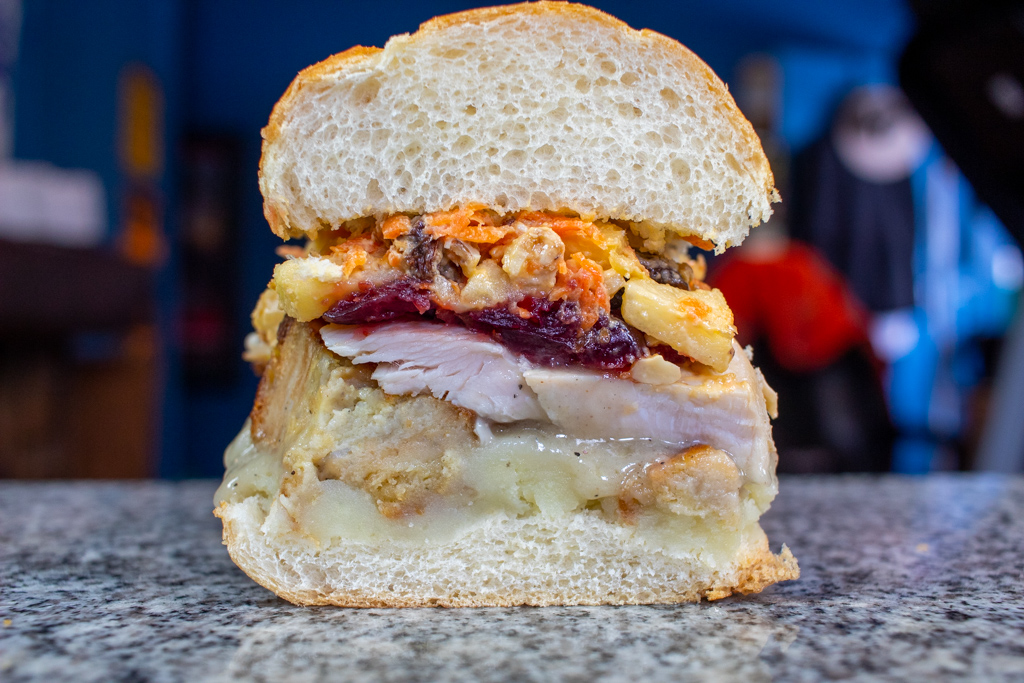
A more minimalist approach was called for, I thought. No mashed potatoes–I’m not a fan of carb-on-carb sandwiches to begin with and they don’t add anything here. Thinner slices of turkey, pan-fried and dressed with a little hot gravy. Thinner slices of stuffing as well, still pan-fried nice and crisp and brown though. Some lettuce, to add a bit of greenery, a bit of crunch. And finally, a new condiment I made up, equal parts cranberry sauce, Duke’s mayonnaise, and Waldorf salad, mixed up in a bowl and pureed a bit with an immersion blender. It may not look like much, but it’s got it where it counts, kids. I call it, “Turkey Dayonnaise.” (I am sorry, I am still not good at naming things)




This sandwich worked. It was balanced–the soft and carb-heavy elements did not overwhelm the delicate turkey flavor, enhanced by a glaze of its own gravy. The sweet and tart and slightly bitter cranberry-and-waldorf-salad mayo held the shredded lettuce in place and rounded out the contrasts that the sandwich needed–hot vs cold, soft vs chewy vs crisp, savory vs sweet.

This is a sandwich I’d make again, if a situation arose where I found myself in possession of enough Thanksgiving leftovers for such an extravagance. Most years, there are simply too many of us vying over the leftovers to get too elaborate. Many a time I’ve found myself eating cold turkey at 2am, sprinkled with a little salt, scooping up cranberry sauce with each slice as if it were French Onion Dip.
So it’s more than likely that I’ll keep things simple in the future–my pan-fried slices of stuffing, my cold salted turkey, a little microwaved gravy when I can scrounge it. However, when it comes to eating Thanksgiving leftovers, the early worm gets the bird, so to speak. I tend to wake up before anybody else, and I tend to get first crack at the leftovers. So my masterpiece, the Eggs Turkeydict? That is on the permanent menu.
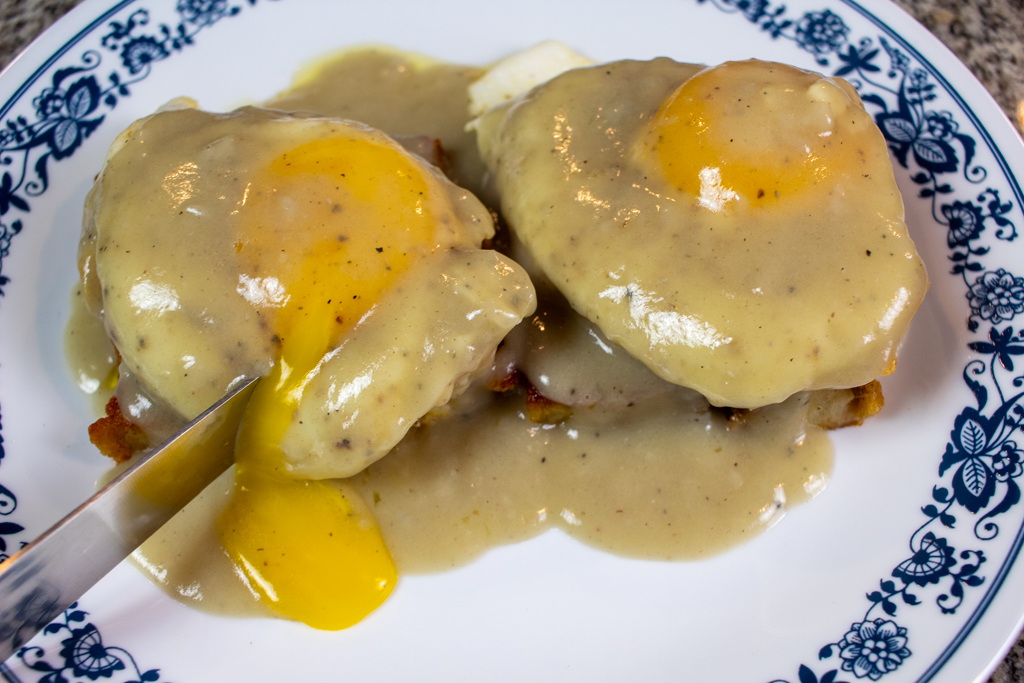

I like sandwiches.
I like a lot of other things too but sandwiches are pretty great


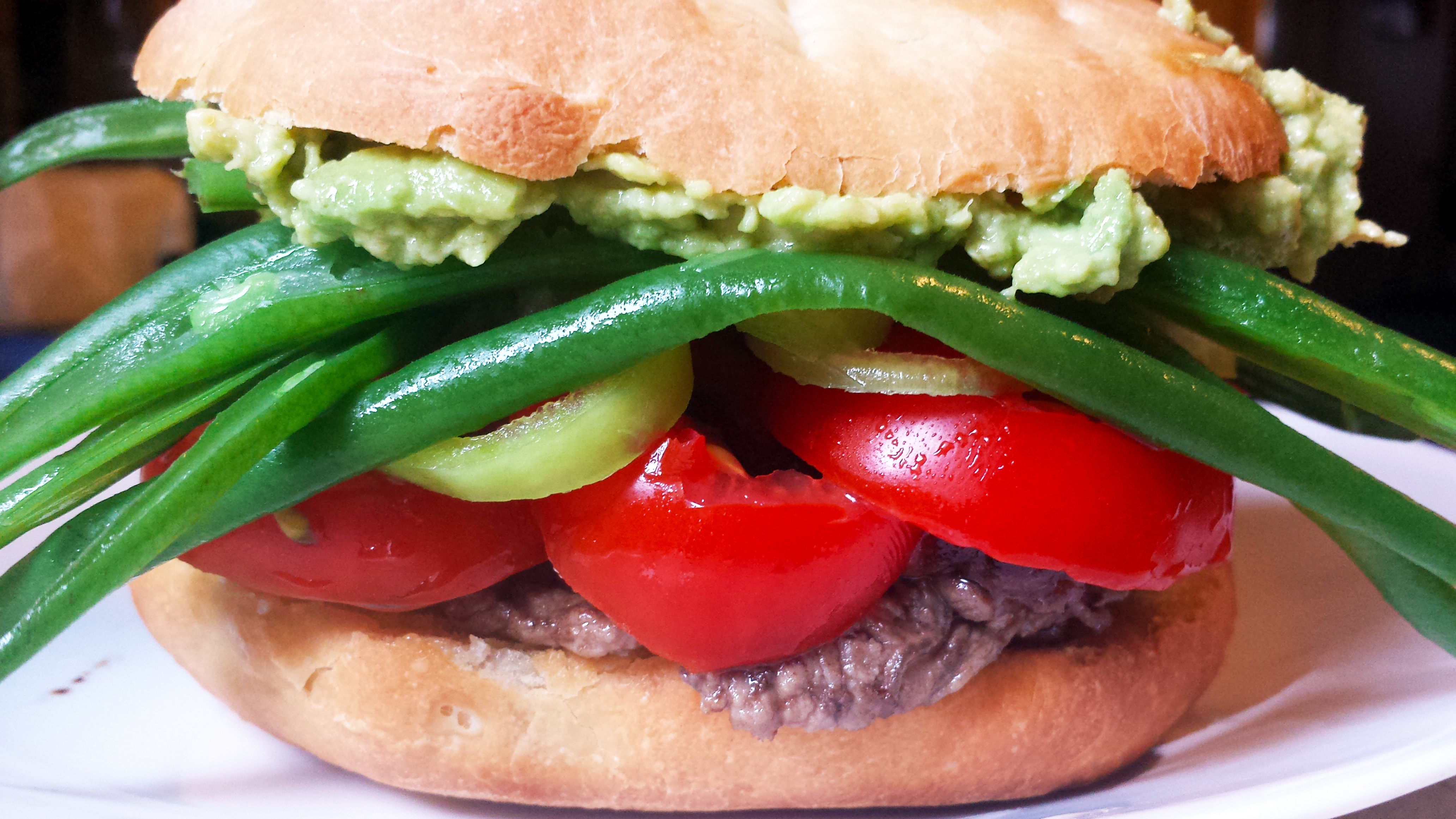








Recent Comments